British-cuisine(英国菜肴简介)
- 格式:docx
- 大小:250.82 KB
- 文档页数:9

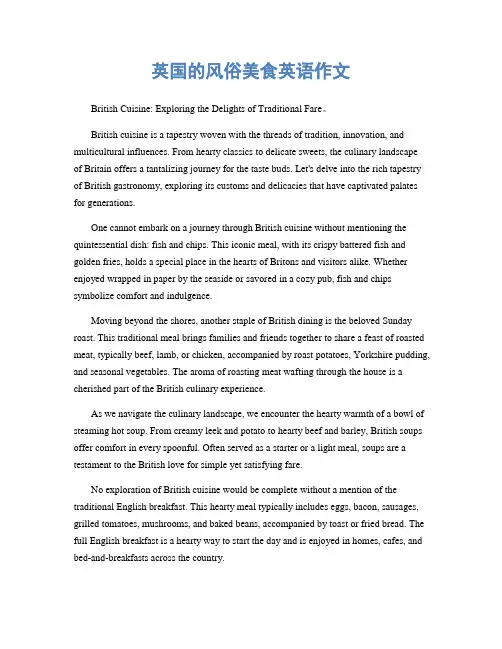
英国的风俗美食英语作文British Cuisine: Exploring the Delights of Traditional Fare。
British cuisine is a tapestry woven with the threads of tradition, innovation, and multicultural influences. From hearty classics to delicate sweets, the culinary landscapeof Britain offers a tantalizing journey for the taste buds. Let's delve into the rich tapestry of British gastronomy, exploring its customs and delicacies that have captivated palates for generations.One cannot embark on a journey through British cuisine without mentioning the quintessential dish: fish and chips. This iconic meal, with its crispy battered fish and golden fries, holds a special place in the hearts of Britons and visitors alike. Whether enjoyed wrapped in paper by the seaside or savored in a cozy pub, fish and chips symbolize comfort and indulgence.Moving beyond the shores, another staple of British dining is the beloved Sunday roast. This traditional meal brings families and friends together to share a feast of roasted meat, typically beef, lamb, or chicken, accompanied by roast potatoes, Yorkshire pudding, and seasonal vegetables. The aroma of roasting meat wafting through the house is a cherished part of the British culinary experience.As we navigate the culinary landscape, we encounter the hearty warmth of a bowl of steaming hot soup. From creamy leek and potato to hearty beef and barley, British soups offer comfort in every spoonful. Often served as a starter or a light meal, soups are a testament to the British love for simple yet satisfying fare.No exploration of British cuisine would be complete without a mention of the traditional English breakfast. This hearty meal typically includes eggs, bacon, sausages, grilled tomatoes, mushrooms, and baked beans, accompanied by toast or fried bread. The full English breakfast is a hearty way to start the day and is enjoyed in homes, cafes, and bed-and-breakfasts across the country.As we satisfy our savory cravings, it's time to indulge our sweet tooth with some of Britain's delectable desserts. From the crumbly goodness of apple crumble to the decadence of sticky toffee pudding, British desserts are a celebration of rich flavors and comforting textures. The tradition of afternoon tea also deserves a mention, with its array of delicate pastries, scones with clotted cream and jam, and, of course, a pot of freshly brewed tea.Beyond the classics, British cuisine continues to evolve, embracing global influences and culinary innovation. From fusion cuisine to Michelin-starred restaurants, Britain's food scene is vibrant and diverse, reflecting the multicultural fabric of the nation.In conclusion, British cuisine is a delightful tapestry woven with tradition, innovation, and multicultural influences. From the iconic fish and chips to the comforting Sunday roast and indulgent desserts, British gastronomy offers a rich and varied culinary experience. Whether enjoyed in a quaint pub, a bustling café, or a fine dining establishment, British cuisine invites us to savor the flavors of tradition and the excitement of innovation. So, let's raise our forks and toast to the delicious delights of British fare!。

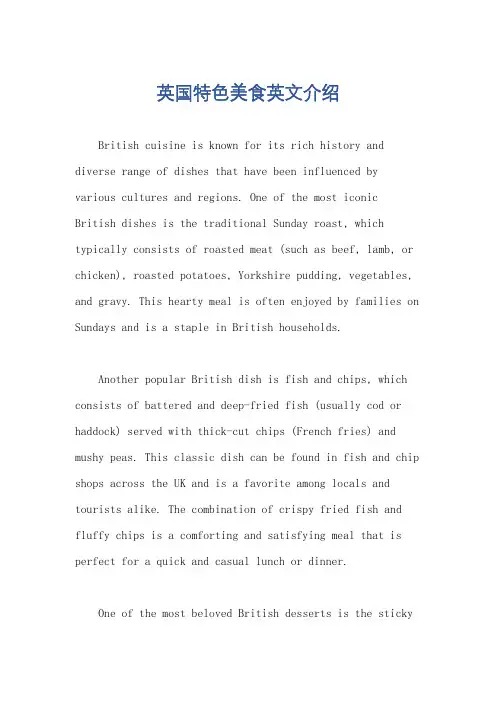
英国特色美食英文介绍British cuisine is known for its rich history and diverse range of dishes that have been influenced by various cultures and regions. One of the most iconicBritish dishes is the traditional Sunday roast, which typically consists of roasted meat (such as beef, lamb, or chicken), roasted potatoes, Yorkshire pudding, vegetables, and gravy. This hearty meal is often enjoyed by families on Sundays and is a staple in British households.Another popular British dish is fish and chips, which consists of battered and deep-fried fish (usually cod or haddock) served with thick-cut chips (French fries) and mushy peas. This classic dish can be found in fish and chip shops across the UK and is a favorite among locals and tourists alike. The combination of crispy fried fish and fluffy chips is a comforting and satisfying meal that is perfect for a quick and casual lunch or dinner.One of the most beloved British desserts is the stickytoffee pudding, a moist sponge cake made with dates and covered in a rich toffee sauce. This indulgent dessert is often served with vanilla ice cream or custard and is a popular choice on restaurant menus and at dinner parties. The combination of sweet dates and sticky toffee sauce creates a decadent and satisfying treat that is sure to satisfy any sweet tooth.Another classic British dessert is the traditional trifle, a layered dessert made with sponge cake, fruit (such as berries or peaches), custard, and whipped cream. Trifles are often served at special occasions and celebrations, such as Christmas and birthdays, and are a favorite among both children and adults. The combination of creamy custard, fluffy sponge cake, and fresh fruit makes trifle a delicious and visually appealing dessert that is sure to impress.In addition to traditional dishes and desserts, British cuisine also features a variety of regional specialtiesthat showcase the diverse culinary traditions of the UK. For example, haggis is a traditional Scottish dish madewith sheep's offal (such as heart, liver, and lungs), oats, and spices, all encased in a sheep's stomach and boiled. This savory dish is often served with neeps and tatties (mashed turnips and potatoes) and is a symbol of Scottish heritage and culture.Overall, British cuisine is a reflection of thecountry's rich history and cultural influences, with a diverse range of dishes and flavors that have evolved over centuries. From hearty Sunday roasts to indulgent desserts like sticky toffee pudding and trifle, British food offers a unique and delicious culinary experience that is sure to delight food lovers around the world. Whether you're enjoying a classic fish and chips by the seaside or savoring a traditional haggis in the Scottish Highlands, British cuisine is a true celebration of flavor, tradition, and innovation.。

英国国菜知识点总结IntroductionBritish cuisine has evolved over centuries, with influences from various cultures and regions. It is often associated with traditional dishes such as fish and chips, meat pies, and English breakfast. However, in recent years, there has been a resurgence of interest in British gastronomy, leading to innovation and modernization of traditional dishes. In this article, we will explore the history, key ingredients, and iconic dishes of British cuisine.HistoryBritish cuisine has been shaped by a long history of invasions, trade, and exploration. The Romans introduced vineyards, fruits, and vegetables to Britain, while the Vikings introduced dairy products and beer. During the medieval period, the Norman conquest brought new methods of cooking and a focus on meat-based dishes. The spice trade with the East Indies led to the incorporation of exotic spices into British cooking.During the British Empire, trade routes brought new ingredients such as tea, sugar, and spices to the country. The Industrial Revolution led to a shift in dietary habits, as people moved from rural areas to cities and began consuming more processed foods. The two World Wars also had an impact on British cuisine, with food rationing leading to changes in eating habits and the preservation of traditional recipes.Key IngredientsBritish cuisine is characterized by the use of simple, fresh ingredients, often sourced from local farmers and producers. Some key ingredients include:- Meat: Beef, lamb, and pork are commonly used in British cooking, often in the form of roasts, stews, and pies.- Fish: Britain's coastal location means that seafood is a key part of the cuisine, with dishes such as fish and chips, seafood pie, and smoked salmon being popular.- Potatoes: Potatoes are a staple in British cooking, often used in dishes such as mashed potatoes, roast potatoes, and potato crisps.- Dairy: Dairy products such as milk, butter, and cheese are important in British cuisine, with cheddar, stilton, and double cream being particular favorites.- Vegetables: British cuisine makes use of a wide variety of vegetables, including carrots, onions, cabbage, and peas, often served as accompaniments to meat or fish dishes.- Breads and Cereals: Breads, pastries, and cereals are also important in British cuisine, with items such as scones, crumpets, and English muffins being particularly iconic.Iconic DishesBritish cuisine is known for its hearty, comforting dishes, many of which have become iconic around the world. Some of these include:- Fish and Chips: This classic dish consists of battered and deep-fried fish, typically cod or haddock, served with thick-cut chips and mushy peas. It is often eaten with salt and vinegar, wrapped in paper, and enjoyed as a takeaway meal.- Roast Dinner: The Sunday roast is a beloved tradition in Britain, featuring a roasted joint of meat, such as beef, lamb, or chicken, served with roast potatoes, Yorkshire pudding, vegetables, and gravy.- English Breakfast: A hearty and indulgent meal, the English breakfast includes items such as bacon, eggs, sausages, baked beans, grilled tomatoes, mushrooms, and toast, often accompanied by a pot of tea.- Meat Pies: Pies are a staple of British cuisine, with fillings such as steak and kidney, chicken and mushroom, and pork and apple being popular choices. They are often served with a generous helping of gravy.- Afternoon Tea: This traditional ritual involves a spread of tea, scones with clotted cream and jam, finger sandwiches, and cakes and pastries, served on a tiered stand. ModernizationIn recent years, British cuisine has undergone a revival, with a focus on modernizing and elevating traditional dishes. This has been driven by a new generation of chefs and food entrepreneurs, who are reinterpreting classic recipes and experimenting with new flavors and techniques. Additionally, there has been a renewed emphasis on sourcing local, sustainable ingredients and supporting independent producers.Modern British cuisine is characterized by creativity, innovation, and a celebration of diversity. Chefs are incorporating influences from around the world, creating fusion dishes that reflect the multicultural nature of contemporary Britain. There is also a growing focus on plant-based and vegetarian options, as well as a greater awareness of food allergies and dietary restrictions.ConclusionBritish cuisine has a rich and diverse history, shaped by centuries of cultural exchange and culinary innovation. While traditional dishes such as fish and chips and roast dinner remain beloved staples, there is also a newfound excitement and creativity surrounding British gastronomy. With its emphasis on quality ingredients and a celebration of local and global flavors, British cuisine continues to evolve and inspire. Whether it's a classic dish served in a cozy pub or a cutting-edge creation from a Michelin-starred restaurant, British cuisine offers something for everyone to savor and enjoy.。
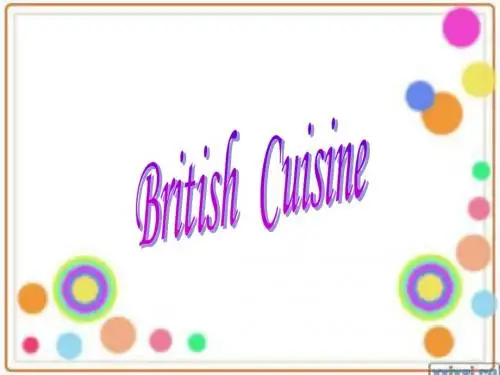
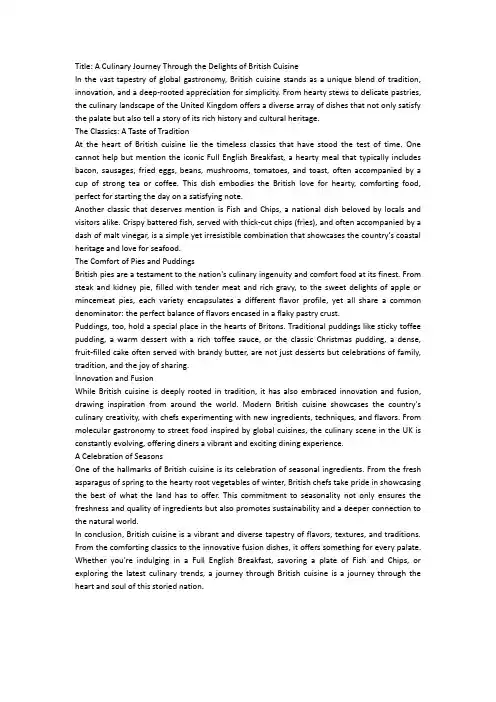
Title: A Culinary Journey Through the Delights of British CuisineIn the vast tapestry of global gastronomy, British cuisine stands as a unique blend of tradition, innovation, and a deep-rooted appreciation for simplicity. From hearty stews to delicate pastries, the culinary landscape of the United Kingdom offers a diverse array of dishes that not only satisfy the palate but also tell a story of its rich history and cultural heritage.The Classics: A Taste of TraditionAt the heart of British cuisine lie the timeless classics that have stood the test of time. One cannot help but mention the iconic Full English Breakfast, a hearty meal that typically includes bacon, sausages, fried eggs, beans, mushrooms, tomatoes, and toast, often accompanied by a cup of strong tea or coffee. This dish embodies the British love for hearty, comforting food, perfect for starting the day on a satisfying note.Another classic that deserves mention is Fish and Chips, a national dish beloved by locals and visitors alike. Crispy battered fish, served with thick-cut chips (fries), and often accompanied by a dash of malt vinegar, is a simple yet irresistible combination that showcases the country's coastal heritage and love for seafood.The Comfort of Pies and PuddingsBritish pies are a testament to the nation's culinary ingenuity and comfort food at its finest. From steak and kidney pie, filled with tender meat and rich gravy, to the sweet delights of apple or mincemeat pies, each variety encapsulates a different flavor profile, yet all share a common denominator: the perfect balance of flavors encased in a flaky pastry crust.Puddings, too, hold a special place in the hearts of Britons. Traditional puddings like sticky toffee pudding, a warm dessert with a rich toffee sauce, or the classic Christmas pudding, a dense, fruit-filled cake often served with brandy butter, are not just desserts but celebrations of family, tradition, and the joy of sharing.Innovation and FusionWhile British cuisine is deeply rooted in tradition, it has also embraced innovation and fusion, drawing inspiration from around the world. Modern British cuisine showcases the country's culinary creativity, with chefs experimenting with new ingredients, techniques, and flavors. From molecular gastronomy to street food inspired by global cuisines, the culinary scene in the UK is constantly evolving, offering diners a vibrant and exciting dining experience.A Celebration of SeasonsOne of the hallmarks of British cuisine is its celebration of seasonal ingredients. From the fresh asparagus of spring to the hearty root vegetables of winter, British chefs take pride in showcasing the best of what the land has to offer. This commitment to seasonality not only ensures the freshness and quality of ingredients but also promotes sustainability and a deeper connection to the natural world.In conclusion, British cuisine is a vibrant and diverse tapestry of flavors, textures, and traditions. From the comforting classics to the innovative fusion dishes, it offers something for every palate. Whether you're indulging in a Full English Breakfast, savoring a plate of Fish and Chips, or exploring the latest culinary trends, a journey through British cuisine is a journey through the heart and soul of this storied nation.。
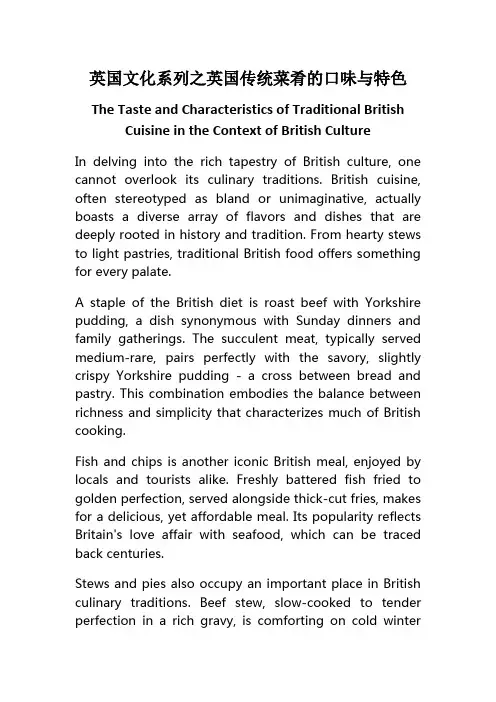
英国文化系列之英国传统菜肴的口味与特色The Taste and Characteristics of Traditional British Cuisine in the Context of British CultureIn delving into the rich tapestry of British culture, one cannot overlook its culinary traditions. British cuisine, often stereotyped as bland or unimaginative, actually boasts a diverse array of flavors and dishes that are deeply rooted in history and tradition. From hearty stews to light pastries, traditional British food offers something for every palate.A staple of the British diet is roast beef with Yorkshire pudding, a dish synonymous with Sunday dinners and family gatherings. The succulent meat, typically served medium-rare, pairs perfectly with the savory, slightly crispy Yorkshire pudding - a cross between bread and pastry. This combination embodies the balance between richness and simplicity that characterizes much of British cooking.Fish and chips is another iconic British meal, enjoyed by locals and tourists alike. Freshly battered fish fried to golden perfection, served alongside thick-cut fries, makes for a delicious, yet affordable meal. Its popularity reflects Britain's love affair with seafood, which can be traced back centuries.Stews and pies also occupy an important place in British culinary traditions. Beef stew, slow-cooked to tender perfection in a rich gravy, is comforting on cold winternights. Meanwhile, meaty pies filled with everything from lamb to venison offer a portable version of this hearty fare. These dishes highlight the use of local ingredients and the importance of preserving flavors through long, slow cooking methods.On the lighter side, scones and teatime treats are integral parts of daily life in Britain. Warm, fluffy scones topped with jam and clotted cream are a delightful way to enjoy a leisurely afternoon tea. A range of cookies and cakes such as Victoria sponge cake and treacle tart round out the sweet offerings, each offering a unique taste experience.Breakfast, known affectionately as "the most important meal of the day," showcases a range of classic British foods. Full English breakfasts featuring sausages, bacon, eggs, beans, mushrooms, and toast provide an energetic start to the day. While porridge, a creamy oatmeal dish, offers a heartier option for those seeking something more substantial.Beyond these staples, regional variations abound in British cuisine. Wales offers dishes like Welsh rarebit (toasted cheese) and Cawl (lamb stew), while Scotland is famous for haggis, neeps, and tatties - a combination of sheep's pluck, turnips, and potatoes. England alone has countless recipe variations depending on location, ranging from Cornish pasties to Lincolnshire plumbread. The influence of other cultures is also evident in modern British cuisine. Indian curries, Chinese takeaways, Italianpizzas, and Greek salads have all found their place in British kitchens, adding diversity and global influences to traditional menus.Overall, British cuisine encompasses a wide spectrum of tastes and textures, reflecting both its historical roots and evolving cultural melting pot. It is a celebration of local produce, seasonal flavors, and family traditions, making it not only delicious but also deeply meaningful within the context of British culture.。

英国十大特色美食英文介绍
英国的美食文化古老而多样,每一种英式食物都有它的独特魅力,让人印象深刻,其中十大特色美食有:英式早餐、烤洋芋、火腿、面包、炒洋葱、红豆布丁、吉普赛炸鱼薯条、牛排、英式菜、搭某。
英式早餐是一道经久不衰的传统英国菜。
它既包含美味可口的火腿切片,芝士;也包括具有地方风味的炸豆腐、洋葱、番茄、蘑菇等组成,几乎是一整餐。
烤洋芋是英式家庭必备的晚餐之一。
烤洋芋可以从最简单的抹上盐和橄榄油开始,也可以加上奶酪以及佐料,从而获得浓郁的口感与风味。
火腿是英国不可或缺的一种食物,火腿口味清甜,带有淡淡的熏烟味,入口即化,是不可多得的美味。
面包是英国人餐桌上必不可少的地标性食物,传统的英式面包有南瓜面包,小
麦面包等,面包上的酥脆和恰到好处的甜味是数不胜数的美食追求者最爱的。
炒洋葱可以把洋葱炒得金黄,嫩滑可口,可以单独食用,也是搭配肉类和面食
等食物一道美味汤羹。
红豆布丁可以利用新鲜的豆子、牛奶、鸡蛋、糖和面粉等制作而成,虽然外表
简单,但融合多种口味的琼浆玉液,口感清甜细腻,实在叫人无法抗拒。
吉普赛炸鱼薯条既有丰富的营养价值,又是一道美味的小吃,皮脆,肉香,营
养丰富是广大食客的最爱。
牛排是英国历史悠久的美食,新鲜当季的牛排出锅后,外层有石灰渲染出一层
嫩黄真香,内层鲜嫩多汁,令人胃口大开。
英式菜是英国传统菜肴,英式菜食材丰富,以混合蔬菜、火腿、海鲜、米饭等
搭配而成,口味清新,十分受欢迎。
搭某是博了英国佬最爱的正餐,搭某上盘一般有面包片,肉馅,O黄油,芝士,蔬菜等组成,所熬煮的肉汁更是多种调料的繁复结合,每一口都带有英式饕餮的。


British CuisineSummary:British cuisine has always suffered from bad press. The simple homespun fare and plain preparation of most traditional British foods pales when compared to French cuisine, and it is not uncommon for food critics to sound almost apologetic when writing about traditional British dishes as if there were something shameful in enjoying a good, thick joint of beef with an accompaniment of Yorkshire pudding. If they speak in glowing terms of anything at all, it is a nod to the ...Keywords:British cuisine, British dishesArticle Body:British cuisine has always suffered from bad press. The simple homespun fare and plain preparation of most traditional British foods pales when compared to French cuisine, and it is not uncommon for food critics to sound almost apologetic when writing about traditional British dishes as if there were something shameful in enjoying a good, thick joint of beef with an accompaniment of Yorkshire pudding. If they speak in glowing terms of anything at all, it is a nod to the clever naming of British foods, where dishes like bubble and squeak and spotted dick appear on restaurant menus.And yet, for all the snickering and apologetic references, British cuisine at its best is hearty, delicious, simple fare on which to fuel the nation that influenced the entire world. There is no other nation in the world that does a roast of beef to such perfection, nor any better accompaniment to the succulent meat than a puffed, piping hot Yorkshire pudding prepared in its drippings, and few cuisines have a dessert that can compare with the pure heaven that is a well made trifle or treacle tart.British cuisine is a blending of the practical with the nutritious. If it is, as some say, unimaginative, that may be because the food itself needs little imagination to fancy it up and make it palatable. It is certainly not because the British mind lacks imagination when it comes to food ?the common names for everyday meals sometimes require a translator just so you could know what is on your plate. A walk through a restaurant take-away menu offers such dishes as peas? steak and kidney pie, fish and chips and bangers and mash.There are well-known British dishes for eating at each meal. Some of the most popular include:Breakfast:A full English country breakfast includes meat, eggs, pancakes or toast and side dishes like hash and bangers and mash. It is hearty fare, the sort that is set on the table for dinner in most other cultures. It often includes leftovers from last night’s dinner, diced and fried together with seasonings and butter, sometimes called country hash. Tea:The tradition of mid-afternoon tea is one that has been observed by the British for centuries. Among the most common dishes served at mid-afternoon tea are finger-foods like crumpets with jam and clotted cream, dainty watercress sandwiches and scones with raisins or dried fruits.Sunday Dinner:The Sunday dinner has a long tradition as being a family occasion? the one meal of the week at which all family members gathered. A roast joint of meat? beef, lamb, pork or chicken? It nearly a requirement, and it is served with a potato and vegetable, and very often accompanied by Yorkshire pudding.Puddings and custards feature prominently in British cuisine. Baked, boiled or steamed, puddings are usually made with suet and breading, and studded with dried fruits and nuts. One of the most popular and delightful British desserts is the trifle, and there are nearly as many variations as there are cooks. The base is a sponge cake, often left over from another meal. Soaked in Madeira or port, it is layered in a dish with custard, jam, fruits and Jell-O and topped with whipped cream. The end result is a delicious waffle that is features all that is good about British cookery? Plain, practical cooking that is meant to fill the belly and satisfy the taste buds.。
英国传统菜肴和餐桌礼仪英语作文Traditional British Cuisine and Dining EtiquetteIntroductionBritish cuisine has a long and rich history, with a wide range of traditional dishes that have become staples in households and restaurants throughout the country. In addition to the delicious food, Brits also take pride in their dining etiquette, which plays a significant role in their culture and society. In this essay, we will explore some of the most popular British traditional dishes and discuss the essential dining etiquette that is observed in the UK.Traditional British Dishes1. Fish and chipsOne of the most iconic British dishes, fish and chips consists of battered and fried fish, usually cod or haddock, served with thick-cut potato chips. This dish is often enjoyed with tartar sauce, vinegar, and mushy peas. Fish and chips are traditionally wrapped in newspaper and eaten with fingers.2. Roast beef and Yorkshire puddingRoast beef and Yorkshire pudding is a classic Sunday roast dish that is popular in Britain. The beef is roasted to perfectionand served with a fluffy Yorkshire pudding, roasted vegetables, and gravy. This hearty meal is enjoyed with family and friends and is a staple in British households.3. Full English breakfastA traditional English breakfast is a hearty meal that typically includes fried eggs, bacon, sausages, beans, mushrooms, tomatoes, toast, and black pudding. This breakfast is usually accompanied by a cup of tea or coffee and is a popular choice for starting the day in the UK.4. Shepherd's pieShepherd's pie is a comforting dish made with minced lamb or beef, topped with mashed potatoes and baked until golden brown. This dish is often served with peas or other vegetables and is a favorite during the colder months in Britain.5. Beef WellingtonBeef Wellington is a luxurious dish made with fillet steak coated in mushroom duxelles, wrapped in puff pastry, and baked until golden and crispy. This dish is often served with a rich red wine jus and is a popular choice for special occasions in Britain.Dining Etiquette in the UK1. Table mannersIn Britain, table manners are essential when dining in a formal setting. Some common table manners include placing your napkin on your lap, using utensils from the outside in, and keeping your elbows off the table. It is also considered polite to wait for everyone to be served before starting your meal and to say "please" and "thank you" to the server.2. Tea etiquetteTea is an important part of British culture, and there are specific rules for how to enjoy a proper cup of tea. When serving tea, it is customary to pour the tea first and then add the milk. It is also important to stir the tea gently and not clink the spoon against the teacup, as this is considered impolite.3. ToastingWhen making a toast in the UK, it is customary to raise your glass, make eye contact with the person you are toasting, and say "cheers" or "to your health." It is also polite to take a sip of your drink after the toast and to avoid clinking glasses together, as this is seen as a sign of aggression.4. TippingTipping in the UK is generally expected in restaurants and bars, and it is customary to tip around 10-15% of the total bill. However, tipping is not mandatory, and it is ultimately up to the individual to decide how much to tip based on the service received.ConclusionTraditional British cuisine and dining etiquette play a significant role in British culture and society. From iconic dishes like fish and chips to formal dining etiquette, British food and dining traditions are steeped in history and tradition. By understanding and appreciating these traditions, we can gain a deeper insight into British culture and enjoy a truly authentic dining experience in the UK.。
英国菜的英文介绍British cuisine"Surely there is nothing special!" I hear you saying as you read the title of this paper. How can bland, boring British cooking possibly compare with the delightful variety of Chinese food, the spiciness of Indian, the sophistication of French food or the all-conquering popularity of Italian pizza and pasta? And you probably say that British cuisine is made in a very simple way: English people would only roast or boil food. Well, I would like to share with the distinguishing features, development history, current situation, eating habits and the most popular food of British cuisine. You would be surprise when I tell you the living fact.Unveiled, the main feature of British cuisine is substantial, yet simple and wholesome, inextricably interwoven with the culture of the country and in no way is made in a simple way. In the first place, British cuisine has always been a blend of various styles and their food has been influenced by the traditions and tastes from different parts of the British Empire: teas from Ceylon and chutney, kedgeree, and mulligatawny soup from India. [1]Also because of Britain's colonial past, the most popular take-away and restaurant food in Britain are Indian cuisine and Chinese dishes, but the dishes served would probably not be recognizable to an Indian or a Chinese. In the second place, due to its long years of colonial history, traditional British cuisine has taken in a variety of styles in the world and now not just delicious but also delicate in no way British cuisine is made in a simple way. Chinese cuisine may have employed more ways of cooking than any other counties, ranging from the frying, roasting, baking, tostew and boiling, British cuisine features roasting and not have as many cooking methods, but both cuisines are delicious.Besides the extensive colonial history, there is still another thing push the British cuisine got on the train of reformation. In the late1980s, British cuisine started to look for a new direction and enjoy a renaissance. Disenchanted with the overblown (and under-nourished) Nouvelle Cuisine, chefs began to look a little closer to home for inspiration. [2]Calling on a rich tradition and utilizing many diverse and interesting ingredients. The basis was formed for what is now known as fashionable modern British food.Above all, incorporating the cooking styles or cuisines of other countries and inspired by the Nouvelle Cuisine, now British food has evolved considerably yet at the same time it retained its originality thus earned international recognition with publication of guide to the world's top 50 restaurants. Five UK eateries are on the list, highest among which is Gordon Ramsay [3] in London's Chelsea. Celebrity chefs like Gordon Ramsay and Jamie Oliver [4]have made British food cool, and the TV schedules are full of cookery programs like Saturday Kitchen, the Naked Chef and Jamie's School Dinners [5]. Nowadays, lighter contemporary British cuisine sits alongside more the traditional cuisine of gentlemen's clubs with its focus on heavy meat-based dishes, pies and game, pudding and cheeses. What's more, each region of Britain has it own characteristic culinary traditions that have played a major role in enriching the history of British cuisine. For instance, pork pies have been identified with the culinary customs of the shires, whereas in Cornwall, the pasty continue to play an important role in the lunch of the workers.[6]Although associating with particular localities, some cuisines in Britain haveattained a national recognition, like the very famous Yorkshire pudding.British cuisine is such a delicious and wholesome food that it became an integral part of celebrations and festivities. British wine is an indispensable part of celebrations in the country. Christmas is the most important festival that is celebrated in the country. During this time, various special dishes are prepared like Christmas pudding, Christmas cake, sponge cake, Christmas Fruit Mincemeat Tarts and many more. [7]Also may be because British cuisine is extremely mouth-watering, they have long believed in four meals a day. The great British breakfast is famed throughout the world. A typical traditional English breakfast would generally consist of baked beans, sausages, mushrooms, eggs, bacon, sandwiches and fried bread. Actually nowadays it is a bit of a myth. T oday many British people are more likely to have a bowl of cornflakes or a cup of coffee with a cigarette than indulge in the wonders of this feast. Standard traditional English Sunday lunch invariably features roasted meat, Yorkshire pudding, potatoes and two other vegetable preparations. Another important point isworth mentioning is that a formal British meal consists of three courses: soup or starter, the main course, which traditionally consist of meat, potatoes and two other vegetables all served on the same plate, and then a dessert followed by cheese, fruit and coffee. The staple diet of 'meat and two vegetables' is so ingrain in the British psyche that they laugh when they see Chinese students fill their plates with totally incongruous combinations of food in university canteens, walking up to the cash register and paying four times as much as they should have because they have put four main coursestogether instead of one main course with a carbohydrate and vegetables.Until now, you must have a good knowledge of the distinguishing feature, development history and eating habits, and you begin to question what the best trendy foods are? Fish and chips are the customary national food of England and the classic English take away food. It became popular in the 1860's when railways began to bring fresh fish straight from the coast to their cities over night. The fish is deep fried in flour batter and is eaten with chips. The fried potatoes are called chips in British and international usage; and while American English calls them "French fries" the combination is still called "fish and chips". American style French fries are typically slimmer than their English counterparts. The traditional way is to fry in oil of beef fat, and this tends to be retained in the north of England and Scotland. In the south vegetable oil is more common. This does impart a distinctive flavor to the dish and mean the chips are acceptable to vegetarians. Traditionally, the fish and chips are covered with salt malt vinegar and, using your fingers, eaten straight out of the newspaper which they were wrapped in. Nowadays small wooden forks are provided and chips are wrapped in more hygienic paper. In the north of England, fish and chips are often served with "mushy peas" (mashed processed peas).However, currently the British seldom has fish or seafood. It sounds strange, because it is an island nation, when you are in England you would not be further than 60km from the sea, and seafood shall be adequate. The reason is fairly straightforward- over fishing in the past that reduced the number of fish sent seafood prices to soar. People now only eat seafood inrestaurants.In conclusion, Britain does have a wide and varied cuisine today instead of being grey boiled meat as people think! After years of disparagement by numerous countries, British now have an enviable culinary reputation. Wouldn't you like to have a try to put down the rebellions of your tongue?Notes:(1)像锡兰茶、印度的酸辣酱、鸡蛋葱豆饭和咖喱肉汤。
介绍美食的英文文章阅读美食作为旅游资源的重要组成部分,在世界各地的旅游发展和城市形象塑造中起着非常重要的作用,美食旅游也逐步成为旅游者竞相追捧的一种新的旅游形式。
下面是店铺带来的介绍美食的英文文章阅读,欢迎阅读!介绍美食的英文文章阅读篇一英国饮食文化之早餐篇Today people in the UK eat a more varied diet than ever before. As well as the regionaldiets of England, Scotland, Wales, and Northern Ireland the many immigrant communities haveintroduced their cuisines to the previously unadventurous Britons: Chinese, Greek, Indian,Italian, Thai, American fast foods such as pizza, hamburgers and fried chicken have to someextent displaced the traditional fast food of fish and chips.今天,人们在英国吃了更多样化的饮食比以往任何时候。
以及区域饮食的英格兰,苏格兰,威尔士和北爱尔兰,许多移民社区介绍了他们的菜以前unadventurous英国人:中国,希腊,印度,意大利,泰国,美国快餐食品,如比萨饼,汉堡包和炸鸡已在一定程度上取代传统的快餐店的炸鱼和薯条。
Because of the climate and the Germanic origins of many of its early people, the UK hasbeen a traditionally beer drinking rather than a wine drinking country. Nevertheless, in recentyears, vineyards in the south of England have proved successful. In the west of England thetraditional drink is cider, rather than beer. Over Britain as a whole, however, the traditionaldrink is tea.由于气候和日耳曼起源及其早期的许多人,英国一直是传统上喝啤酒,而不是葡萄酒的饮用国。
英国菜有哪些特色留学,这个字眼对你来说够不够诱惑?留学地的美食,更是难以抵挡的诱惑吧!随着中西方文化的不断交融和碰撞,越来越多的人选择店铺。
你在接受国外先进教学理念的同时,也可以享受异域美食带来的味觉冲击。
原汁原味英国餐英国,一个在国际上具有重要地位和影响力的西欧国家,人口5000多万,绝大部分为英格兰人,此外还有苏格兰人、威尔士人及爱尔兰人。
公元1066年,法国的诺曼底公爵威廉继承了英国王位,带来了灿烂的法国和意大利饮食文化,为传统的英国菜打下基础。
但是,受地理及自然条件所限,英国的农业并不发达,粮食每年都要进口,英国菜相对来说比较简单。
不过英式早餐却很丰富,英式下午茶更是以其丰盛和精致著称。
英国菜的主要特色,是简单而有效地使用优质原料,并尽可能保持其原有的质地和风味。
英国菜的烹调对原料的取舍不多,一般用单一的原料制作,要求厨师不加配料,保持菜式的原汁原味。
英国人不讲究吃海鲜,比较偏爱牛肉、羊肉、禽类等,常见的英式菜有土豆烩羊肉、牛尾汤、烤羊马鞍、烧鹅等。
不得不尝的英式快餐--炸鱼薯条在权威美食杂志公布的"全世界50最佳餐厅"中,就有14间在英国,足见英国菜受欢迎的程度。
很多人应该还记得,初中的英文课本上有一篇介绍英国传统食品的文章,这种堪称英国食物界国粹的美食,就是炸鱼薯条。
那是正宗的英式快餐,可以堂吃,也可以用纸一裹来外带。
如果来到英国,你一定不要错过这项国吃。
炸鱼是将海鱼在面浆里打个滚,然后下油锅,大多再蘸点盐或者醋即可。
鱼肉滑嫩,热气喷涌,外面金灿灿的面壳更是脆生生。
鱼旁边还有一大份土豆,根根都有拇指粗,也是泛着漂亮的金光,吃到嘴里外脆里糯,回味无穷。
3-4英镑就能填饱肚子,如果添50个便士,还可以要一碟咖喱来调味。
炸鱼薯条店遍布英国,它们还经营炸香肠、炸蘑菇、炸肉排,炸得不亦乐乎,很是热闹!。
British-cuisine(英国菜肴简介)British CuisineBritish CuisineAlthough Britain doesn’t have the best of reputations for its food, the people of Britain do in fact enjoy an enormously varied diet. And, although, its cuisine might not be world-renowned, it would be a mistake to completely ignoreits delights. My article attempts to give you an insight into the British diet, way of eating, and includes a timeline for the typical Briton’s meals.General IntroductionBritish cuisine has traditionally been limited in its international recognition to the full breakfast, fish and chips, and the Christmas dinner. Other famous British dishes include the Sunday roast, steak and kidney pie, shepherd's pie, and bangers and mash. British cuisine has many regional varieties within the broader categories of English, Scottishand Welsh cuisine. Each have developed their own regional or local dishes, many of which are geographically indicated foods such as Cornish pasties, the Yorkshire pudding, Arbroath Smokie, and Welsh cakes.British cuisine is the specific set of cooking traditions and practices associated with the United Kingdom. British cuisine has been described as "unfussy dishes made with quality local ingredients, matched with simple sauces to accentuate flavour, rather than disguise it." However, British cuisine has absorbed the cultural influence of those that have settled in Britain, producing hybrid dishes, such as the Anglo-Indian chicken tikka masala.The Norman conquest introduced exotic spices into England in the Middle Ages. The British Empire facilitated a knowledge of India's elaborate food tradition of "strong, penetrating spices and herbs". Food rationing policies, put in place by the British government during wartime periods of the 20th century, are said to have been the stimulus for British cuisine's poor international reputation. Contrary to popular belief, people in southern England eat more garlic per head than the people of northern France.Traditional Briton’s Favorite FoodsBubble and Squeak. The name of this dish refers to the sound it makes while cooking. This recipe can be modified by substituting the brussel sprouts with any left-over vegetables you might have in the kitchen (boiled cabbage, carrots, leeks, etc.). This dish is perfect with “HP” brown sauce— another British culinary tradition!Cheese and Onion Pie. A tradition filled pastry pie. Some families, in the north of England, add potatoes to this recipe. Serve with chips (french fries) and baked beans in tomato sauce.Haggis. Haggis is a purely Scottish dish, and is typically served on “Burns night”, 25th January, when Scotland celebrates the birth of its greatest poet, Robert Burns, who was born in Ayrshire on that date in 1759. The haggis is quite simply a large boiling sausage stuffed with a variety of meat and oatmeal, flavoured with onion and seasoning.A Timeline for Britons’ MealsBreakfast. Traditionally manyBritons have started the day withsomething called a “full EnglishBreakfast”. This typically comprises ofthe following things: toasted bread,spread with butter, jam, marmalade or honey; followed by a “fry up”or cooked breakfast of fried bread, sausages, bacon, mushrooms, eggs and tomatoes. Served with hot tea, with milk added. However, with today’s fast lifestyle and an increasing awareness of healthy eating this traditional breakfast is not largely eaten only at the weekend, and has been replaced by another in most British households. A typical modern breakfast comprises: fruit juice, toast and jam, packet cereal (cornflakes or similar), and tea .Elevenses. In some households and workplaces this is followed by something called“elevenses”. This consistsof a cup of tea or coffee andsome biscuits. Actually“elevenses” can be taken atanytime of the day, and withmost Britons this is usually fairly often!Lunch. Lunch can be anytime between 12:30 and 2pm. Some people might have a sandwich, while others will have afull-cooked meal. In schools this meal is referred to as “dinner”.Teatime. Tea has been an important drink in Great Britainfor hundreds of years, and is drunk throughout the day in most British households. The typical “Teatime” is served at any time between four an d five o’clock and for the majority of the population is a cup of tea, a sandwich or two and some cake. Some families, notably from the working classes, have their main evening meal at this time.Dinner. Dinner is the usual name for the main evening meal. It can be served anytime between 6pm and 8pm and for most families is the biggest meal of the day.Supper. Supper is the final meal of the day, and is usually something very light like a sandwich and a cup of tea. Nowadays this meal is usually eaten in front of the television! Before going to bed many Britons drink a drink made from hot milk. Usually either plain boiled milk, chocolate, or “Horlicks”,“Ovaltine” (two brand-name drinks made from Barley and Malt).Sunday Lunch—Family’s Happy TimeSunday lunch was popular in the 1960s, today most British families still spend Sundays in exactly the same manner with their parents and grandparents.On Sundays people don’t usually have to work so they take the opportunity to eat together with their family. A typicalSunday lunch might be eaten between 1pm and 2pm and include roast beef and Yorkshire pudding, roast potatoes, boiled vegetables, and gravy (meat sauce). However, many families now eat less beef, so other roast meat is often eaten —lamb, pork, chicken, turkey or duck. Some families will also follow the main meal with a dessert such as “apple pie and custard”Excerpts from the Works of C .S .LewisYou can find many of the typical ingredients of a British diet in these classics:“She had a vague impression of dwarfs crowding around the fire with frying pans rather bigger than themselves, and the hissing and delicious smell of sausages, and more and more sausages. And not wretched sausages half full of bread and soya bean either, but real meaty, spicy ones, fat and piping hot and burst and just the tiniest bit burnt .And great mugs of frothy chocolate, and roast potatoes and roast chestnuts, and baked apples with raisins stuck in where the cores had been, and then ices just to freshen you up after all the hot things”—THE SILVER CHAIR “Mrs. Beaver brought out of the oven a great and gloriously sticky marmalade roll, steaming hot, and at the same time moved the kettle onto the fire, so that when theyhad finished the marmalade roll the tea was made and ready to be poured out.”—THE LION, THE WITCH AND THE WARDROBE.。